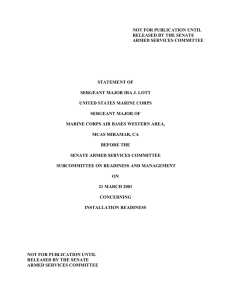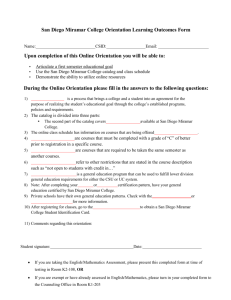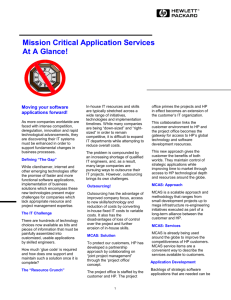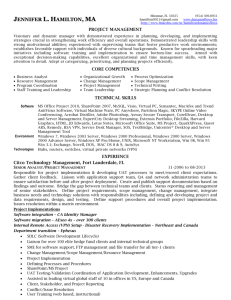Document 11053923
advertisement
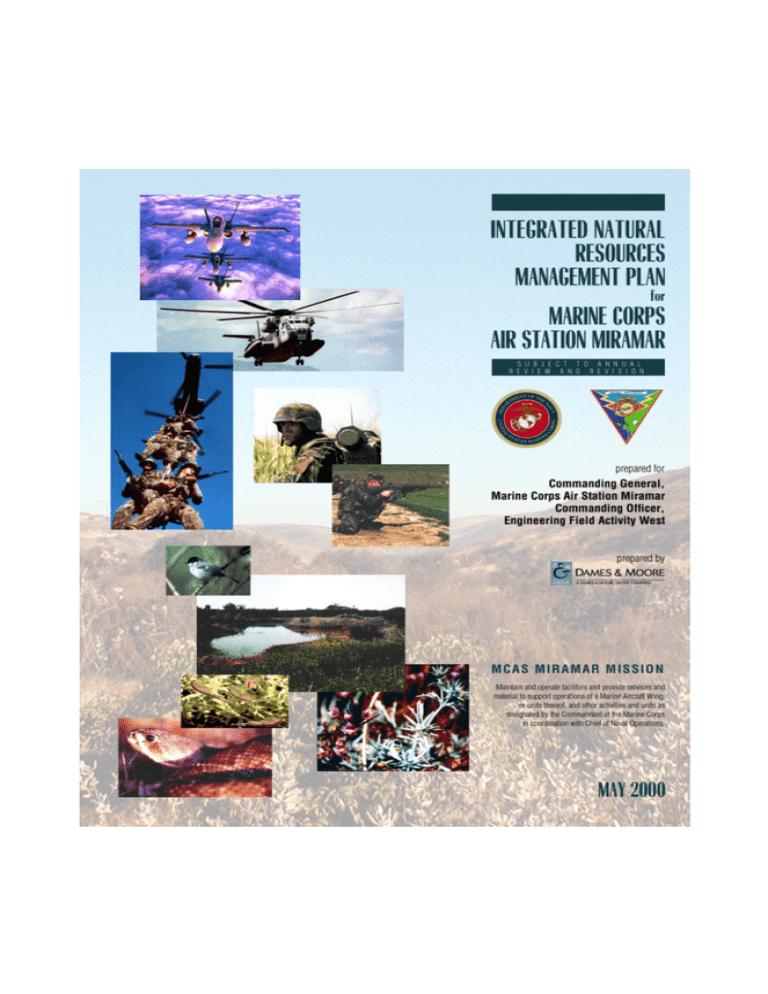
INTEGRATED NATURAL RESOURCES MANAGEMENT PLAN FOR MARINE CORPS AIR STATION MIRAMAR SUBJECT TO ANNUAL REVIEW AND REVISION Prepared for Commanding General, Marine Corps Air Station Miramar Commanding Officer, Engineering Field Activity West Prepared by Dames & Moore, Inc. MCAS MIRAMAR MISSION Maintain and operate facilities and provide services and material to support operations of a Marine Aircraft Wing, or units thereof, and other activities and units as designated by the Commandant of the Marine Corps in coordination with Chief of Naval Operations. Recommended citation: MCAS Miramar 2000. Integrated Natural Resources Management Plan for Marine Corps Air Station Miramar. . May 2000 TABLE OF CONTENTS Executive Summary.....................................................................................................................ES-1 1.0 Introduction....................................................................................................................... 1.1 Purpose of the INRMP ............................................................................................. 1.1.1 Requirement for Preparation of an INRMP.................................................... 1.1.2 Approvals and Revisions ............................................................................... 1.1.3 Relationship to Regional Conservation Planning Efforts................................... 1.2 Military Mission........................................................................................................ 1.3 Management Approach............................................................................................. 1.4 Goals ..................................................................................................................... 1.5 Location and Environmental Setting ........................................................................... 1.6 Existing Natural Resource Management ..................................................................... 1- 1 1- 1 1- 1 1- 2 1- 2 1- 3 1- 4 1- 4 1- 5 1- 6 2.0 MCAS Miramar Land Use................................................................................................. 2.1 Overview.................................................................................................................. 2.2 Land Use History...................................................................................................... 2.3 Military Operational Requirements............................................................................. 2.3.1 Battle Skills Training...................................................................................... 2.3.2 Vehicle Operations ....................................................................................... 2.3.3 Marine Wing Support Service Operations...................................................... 2.3.4 Aviation Operations ...................................................................................... 2.4 MCAS Miramar Military Land Use........................................................................... 2.4.1 Operational Military Uses of MCAS Miramar................................................ 2.4.2 Non-operational Military Uses of MCAS Miramar ........................................ 2.5 MCAS Miramar Non-military Land Use.................................................................... 2.5.1 Current and Proposed Non-military Use of MCAS Miramar.......................... 2.6 Adjacent Land Use ................................................................................................... 2- 1 2- 1 2- 2 2- 4 2- 5 2- 6 2- 7 2- 7 2- 8 2- 8 2-10 2-10 2-10 2-18 3.0 Physical Setting.................................................................................................................. 3- 1 3.1 Climate.....................................................................................................................3- 1 3.2 Geology and Soils ..................................................................................................... 3- 1 3.2.1 Erosion Hazard Ratings ................................................................................. 3- 2 3.2.2 Topography.................................................................................................. 3- 2 3.3 Hydrology and Watersheds....................................................................................... 3- 2 3.3.1 Watersheds................................................................................................... 3- 2 3.3.2 Floodplains and Impoundments ..................................................................... 3- 5 3.3.3 Water Quality............................................................................................... 3- 5 3.4 Potentially Contaminated Sites and Unexploded Ordnance Hazards ........................... 3- 5 W:\00124\304\4_20_00\COVTOC.DOC i Table of Contents (continued) 4.0 Description of Biological Resources.................................................................................... 4.1 Overview.................................................................................................................. 4.2 Vegetation and Landcover Types............................................................................... 4.2.1 Coastal Sage Scrub....................................................................................... 4.2.2 Chaparral...................................................................................................... 4.2.3 Coastal Sage/Chaparral Scrub....................................................................... 4.2.4 Grasslands.................................................................................................... 4.2.5 Vernal Marsh................................................................................................ 4.2.6 Fresh Water Marsh....................................................................................... 4.2.7 Riparian Forests............................................................................................ 4.2.8 Willow Scrub ................................................................................................ 4.2.9 Mulefat Scrub ............................................................................................... 4.2.10 Coast Live Oak Woodland............................................................................ 4.2.11 Eucalyptus Woodland.................................................................................... 4.2.12 Open Water.................................................................................................. 4.2.13 Natural Flood Channel/Streambed................................................................. 4.2.14 Disturbed Habitat (Vegetation)....................................................................... 4.2.15 Developed .................................................................................................... 4.3 Vernal Pools.............................................................................................................. 4.4 Wildlife and Wildlife Habitat....................................................................................... 4.5 Habitat Linkages and Wildlife Corridors..................................................................... 4.5.1 Habitat Linkages........................................................................................... 4.5.2 Wildlife Corridors.......................................................................................... 4.6 Special Status Species............................................................................................... 4.7 Other Species of Regional Special Concern............................................................... 4.8 Habitat Evaluation Model.......................................................................................... 4.8.1 Habitat Evaluation Elements........................................................................... 4.8.2 Compilation of the Habitat Evaluation Model................................................. 4.8.3 Use of the Habitat Evaluation Model.............................................................. 4- 1 4- 1 4- 1 4- 1 4- 2 4- 2 4- 4 4- 4 4- 4 4- 4 4- 5 4- 5 4- 5 4- 5 4- 5 4- 5 4- 6 4- 6 4- 6 4- 9 4-10 4-10 4-14 4-16 4-16 4-19 4-20 4-26 4-26 5.0 Management Area Designations and Land Use Compatibility.............................................. 5.1 Management Area Designations................................................................................. 5.1.1 Level I MAs ................................................................................................. 5.1.2 Level II MAs ................................................................................................ 5.1.3 Level III MAs............................................................................................... 5.1.4 Level IV MAs............................................................................................... 5.1.5 Level V MAs................................................................................................ 5.1.6 Other MA Design Considerations.................................................................. 5- 1 5- 1 5- 2 5- 2 5- 6 5- 7 5- 7 5- 7 W:\00124\304\4_20_00\COVTOC.DOC ii Table of Contents (continued) 5.2 Land Use Compatibility............................................................................................. 5.2.1 General Compatibility Considerations Relative to Management Areas............. 5.2.2 General Requirements for All Areas............................................................... 5.2.3 Actions Programmatically Compatible with Natural Resources Conservation................................................................................ MCAS Miramar’s Conservation Contribution............................................................ 5-11 5-12 6.0 Project and Mitigation Planning........................................................................................... 6.1 Project Planning........................................................................................................ 6.1.1 National Environment Policy Act Considerations............................................ 6.1.2 Natural Resource Specific Considerations...................................................... 6.2 Mitigation Planning.................................................................................................... 6.2.1 Existing Mitigation Actions............................................................................. 6.2.2 Mitigation Planning Guidance......................................................................... 6.2.3 Planning Alternatives for Future Mitigation..................................................... 6- 1 6- 1 6- 1 6- 2 6- 8 6- 9 6-10 6-21 7.0 Policies, Objectives, and Planned Actions for INRMP Components.................................... 7.1 Overview.................................................................................................................. 7.2 Vegetation Management and Soil Conservation.......................................................... 7.2.1 Overview...................................................................................................... 7.2.2 General Vegetation Management and Soil Conservation................................. 7.2.3 Watershed and Floodplain Management ........................................................ 7.2.4 Wildland Fire Management............................................................................ 7.2.5 Grounds Maintenance and Landscaping......................................................... 7.3 Management of Special Status Species...................................................................... 7.3.1 Policy and Background ................................................................................. 7.3.2 Objective(s) and Planned Actions.................................................................. 7.4 Vernal Pool and Other Wetlands Management ........................................................... 7.4.1 Overview...................................................................................................... 7.4.2 Vernal Pool Management............................................................................... 7.4.3 General Wetlands Management ..................................................................... 7.5 Fish and Wildlife Management ................................................................................... 7.5.1 Overview...................................................................................................... 7.5.2 General Wildlife Management ........................................................................ 7.5.3 Migratory Bird Management.......................................................................... 7.5.4 Wildlife Damage Management (Including Bird and Animal Air Strike Hazard) .............................................................................................. 7.5.5 Integrated Pest Management ......................................................................... 7- 1 7- 1 7- 2 7- 2 7- 3 7- 6 7- 7 7-11 7-12 7-12 7-13 7-16 7-16 7-16 7-22 7-23 7-23 7-24 7-25 5.3 W:\00124\304\4_20_00\COVTOC.DOC iii 5- 8 5- 8 5- 9 7-27 7-29 Table of Contents (continued) 7.6 7.7 Natural Resources-Related Outdoor Recreation Management .................................... 7.6.1 Policy and Background ................................................................................. 7.6.2 Objective(s) and Planned Actions.................................................................. Geographic Information Systems and Global Positioning Systems ............................... 7.7.1 Policy and Background ................................................................................. 7.7.2 Objective(s) and Planned Actions.................................................................. 7-30 7-30 7-33 7-34 7-34 7-35 8.0 Environmental Awareness, Compliance, and Law Enforcement............................................ 8- 1 9.0 Literature Cited.................................................................................................................. 9- 1 Appendices A - Legislation and Regulations B - Department of Defense Instruction 4715.3 C – Marine Corps Order P5090.2A, Chapter 11 D – Plant Species Known to Occur at MCAS Miramar E – Animal Species Observed or Potentially Occurring at MCAS Miramar LIST OF TABLES 1 Special Status Species at MCAS Miramar.......................................................................... 4-27 2 Other Species of Regional Special Concern at MCAS Miramar.......................................... 4-29 3 Vernal Pools, Special Status Species, and Other Species of Regional Special Concern by Management Area................................................................. 5- 3 4 Vegetation and Landcover Types by Management Area ...................................................... 5-12 5 Mitigation Guidance for Temporary Habitat Impacts............................................................ 6-14 6. Mitigation Guidance for Permanent Habitat Impacts............................................................ 6-15 7 Checklist of High Priority Planned Actions .......................................................................... 7-35 W:\00124\304\4_20_00\COVTOC.DOC iv LIST OF FIGURES 1 2 Regional Location of MCAS Miramar................................................................................ 1- 7 MCAS Miramar and Surrounding Areas............................................................................. 1- 8 3 4 Current Land Use Sectors, Training Areas, Constraints, and Special Natural Resource Areas ..................................................................................................... 2- 3 Current and Proposed Non-military Uses of MCAS Miramar ............................................. 2-12 5 6 Soils of MCAS Miramar ................................................................................................... 3- 3 Topography and Hydrology of MCAS Miramar ................................................................. 3- 4 7 8 9 10 11 12 13 14 15 16 Vegetation and Landcover Types........................................................................................ Distribution of Vernal Pool Resources and Management Units ............................................. Wildlife Corridors on Western MCAS Miramar.................................................................. Wildlife Corridors on Eastern MCAS Miramar ................................................................... Regional Corridors and Linkages........................................................................................ Distribution of California Gnatcatcher, Least Bell's Vireo, and Willowy Monardella ............. Distribution of Other Species of Special Concern................................................................ GIS Habitat Evaluation Model for MCAS Miramar ........................................................... Habitat Value Index Layer of Habitat Evaluation Model....................................................... Habitat Evaluation Model Composite Map ......................................................................... 17 18 Management Area Designations.......................................................................................... 5- 5 Multi-Habitat Planning Area for the Multiple Species Conservation Program Study Area ..................................................................................... 5-15 19 NEPA Process Chart ......................................................................................................... 6- 3 W:\00124\304\4_20_00\COVTOC.DOC v 4- 3 4- 8 4-11 4-12 4-13 4-17 4-18 4-21 4-24 4-25 ACRONYMS ACOE AGL APZ ARFF Army Corps of Engineers Above Ground Level Accident Potential Zone Aircraft Rescue Fire Fighting BAASH BMP BRAC Bird Air Animal Strike Hazard Best Management Practice Base Realignment and Closure C CalTrans CDFG CE CNPS COMCABWEST CR CSC CWA Candidate Threatened or Endangered Species California Department of Transportation California Department of Fish and Game California Endangered Species California Native Plant Society Commander, Marine Corps Air Bases, Western Area California Rare Species California Species of Special Concern Clean Water Act DoD DON DRMO DSSC DSWA Department of Defense Department of Navy Defense Reutilization Marketing Office Direct Support Stock Control Defense Special Warfare Agency EA EIS EPA ESA ESQD Environmental Assessment Environmental Impact Statement Environmental Protection Agency Endangered Species Act Explosive Safety Quantity Distance FE FP FT Federal Endangered Species Fully Protected Federal Threatened Species GIS GPS Geographic Information System Global Positioning Systems HEM Habitat Evaluation Model W:\00124\304\4_20_00\COVTOC.DOC vi I-805 INRMP Interstate 805 Integrated Natural Resources Management Plan kV Kilovolt LTEM Long-Term Ecosystem Monitoring MA MAPS MBTA MCAS MCO MHMP MHPA MSCP MCCS Management Area Monitoring Avian Productivity and Survivorship Migratory Bird Treaty Act Marine Corps Air Station Marine Corps Order Multispecies Habitat Management Plan Multi-Habitat Planning Area Multiple Species Conservation Program Marine Corps Community Services NAS NASA NBC NCCP NEPA NRD NSPF Naval Air Station National Aeronautics and Space Administration Nuclear, Biological, and Chemical Natural Community Conservation Planning National Environmental Policy Act Natural Resources Division Northern Sludge Processing Facility PE PIF PT Federally Proposed Endangered Species Parameters in Flight Federally Proposed Threatened Species RNA Research Natural Area SDCWA SDG&E SDZ SMART SSC San Diego County Water Authority San Diego Gas and Electric Surface Danger Zone Specific, Measurable, Achievable, Realistic, and Time-fixed Species of Special Concern (former candidates for Federal listing) USFWS United States Fish and Wildlife Service WW World War W:\00124\304\4_20_00\COVTOC.DOC vii EXECUTIVE SUMMARY INTRODUCTION This Integrated Natural Resources Management Plan (INRMP) shows the interrelationships between individual components of natural resources management (e.g., vegetation, wetlands, fish and wildlife), mission requirements and other land use activities affecting Marine Corps Air Station (MCAS) Miramar's natural resources. The INRMP integrates current and future land use activities at MCAS Miramar with natural resources management and conservation. The INRMP was developed in cooperation with the U.S. Fish and Wildlife Service, Army Corps of Engineers, and California Department of Fish and Game. This cooperation ensured and reflected mutual agreement that the INRMP complies with the requirements of the Endangered Species Act (ESA) established in the Biological Opinion for the Realignment of Naval Air Station Miramar to the MCAS Miramar, the Clean Water Act (CWA) Permit from the Army Corps of Engineers, and the Sikes Act Improvement Act of 1997. The INRMP contains the baseline information that supports compliance with regulatory and planning processes, such as those required by the National Environmental Policy Act (NEPA), ESA, and CWA. The INRMP is intended to be a technical document to be used by persons planning and/or preparing Station approvals, management actions, orders, instructions, guidelines, standard operating procedures, and other plans. The INRMP provides technical guidance for the integration of natural resource issues and concerns into facilities and operational planning in accordance with the NEPA decision-making processes. The INRMP is not intended to be used by persons operating in the field. Field personnel are expected to be operating under Station guidelines, plans, orders, or other approvals that have been developed using the INRMP and have already had environmental compliance review and, where applicable, regulatory approvals and/or permitting. The mission of MCAS Miramar is to maintain and operate facilities and provide services and material to support operations of a Marine Aircraft Wing, or units thereof, and other activities and units as designated by Commandant of the Marine Corps in coordination with the Chief of Naval Operations. The Station is managed under the purview of the Commander, Marine Air Bases, Western Area (COMCABWEST). The Assistant Chief of Staff, Environmental Management for COMCABWEST, is responsible for environmental compliance on the Station. The mission of the Third Marine Air Wing, the Station’s primary tenant, is to "Provide combat-ready, expeditionary aviation forces capable of short-notice, world-wide employment to Marine Air Ground Task Force, fleet, and unified commanders." The Station’s overall approach to managing natural resources follows the principles of ecosystem management, consistent with the Marine Corps’ policy. MCAS Miramar’s overall strategy for conservation and management is to limit activities; avoid development; perform mitigation actions in areas supporting high densities of predominantly vernal pools and other wetlands, threatened or endangered species; and manage activities and development in areas with low densities, or no regulated resources, with site-specific measures and programmatic instructions. W:\00124\304\4_20_00\EXSUM.DOC ES-1 The Marine Corps’ goals for natural resources management along with those specifically adopted for MCAS Miramar provided guidance for the development of the INRMP. A critical goal of the INRMP is to support the Marine Corps military mission by ensuring compliance with applicable environmental laws and regulations. The Station has a long publicly acknowledged history of outstanding natural resources stewardship that will be continued through the implementation of the INRMP. LAND USE Land use at the Station reflects MCAS Miramar’s role as a facility supporting Marine Corps’ operational training requirements as well as non-military uses. The Marine Corps has a unique defense mission among the nation’s armed services of being able to field, on virtually immediate notice, a self-sufficient air and ground combat force trained as an integrated team under a single command. To prepare for this mission, the Marine Corps must maintain the flexibility to train its units so they are prepared for the challenges they may face in combat. MCAS Miramar is an important facility for satisfying these training requirements. The Station has functioned as a military facility since World War I. Since Marines must satisfy annual training requirements designed to keep all personnel prepared for deployment and combat, military operational requirements are described in Chapter 2. Operational military uses are described relative to three general geographic and functional sectors. The Main Station at MCAS Miramar is largely developed and contains facilities that support the primary military functions of MCAS Miramar. Military land uses include the airfield and aircraft operation areas, maintenance, supply, community support, recreation, and residential facilities. South/West Miramar is contiguous with the southern and western borders of the Main Station. This area encompasses non-military developments such as landfills, a sand and gravel operation, and a sludge processing facility. East Miramar is located east of Kearny Villa Road. Primary military land uses in this area include infantry training, ordnance operations, small arms ranges, and warehousing. Non-operational military uses include proposed housing on Miramar, a wholesale nursery, and uses associated with Marine Corps Community Services (MCCS). Current and proposed non-military lands uses on MCAS Miramar include landfills, road developments, and a trap and skeet club, along with several other facilities, leases, and easements. MCAS Miramar also supports a Research Natural Area and the Miramar Mounds National Natural Landmark. These areas were designated for their natural resource values. Land use in the vicinity of MCAS Miramar is primarily open space, industrial, commercial, office, and residential. NATURAL RESOURCES Chapters 3 provides users of the INRMP with information on the physical setting needed to integrate and implement natural resource conservation with other Station planning and decision making processes. Information on climate, geology, soils, hydrology, and watersheds provides a basis for understanding information presented on management, land use compatibility, conservation, policies, INRMP objectives, and planned actions presented in subsequent chapters. The Mediterranean climate creates a semi-arid W:\00124\304\4_20_00\EXSUM.DOC ES-2 condition, with warm, dry summers and mild winters. Fog is common during the summer. An important characteristic of local weather is its year-to-year variability. The native vegetation is adapted to periodic drought and flooding. Erosion and sedimentation patterns are influenced by this variability, with most of the soil loss occurring perhaps once every 20 years. Almost all MCAS Miramar's soils are extremely erodible. Hazardous fire conditions occur during the fall when there are very dry, warm winds and vegetation is dry and cover is low. Local watersheds drain to the south or southwest. Murphy, Elanus, Oak, Spring, Quail, Little Sycamore, West Sycamore, and Sycamore canyons drain into the San Diego River and then to the coast. San Clemente Canyon enters Rose Canyon and then Mission Bay. Carroll and Beeler canyons eventually end up in Soledad Valley and then proceed to the coast. Many of these watersheds wholly or partly originate on MCAS Miramar, the main exceptions being Sycamore and Beeler canyons. Chapter 4 describes the biological resources on MCAS Miramar as well as the Station’s relationship to surrounding areas in terms of habitat linkages and wildlife corridors. There are approximately 19,244 acres of vegetated land on the Station, of which approximately 2,651 acres are, to varying degrees, disturbed. Approximately 3,619 acres are developed (e.g., buildings, pavement, etc.). The undeveloped portions of the Station provide valuable habitat for a variety of protected plant and wildlife species. For example, the coastal sage scrub and chaparral vegetation types provide habitat for the threatened coastal California gnatcatcher. In all, sixteen species of plants and wildlife receiving federal protection under the ESA are known to occur on the Station. Six species protected by the ESA are present in the vernal pools on the Station. Vernal pools are essential to the survival of these species. Vernal pools are ephemeral wetlands and are, therefore, also protected by the CWA. Approximately 80 percent of the known vernal pools remaining in San Diego County occur on MCAS Miramar. The importance of this increasingly rare natural resource is highlighted throughout the INRMP. Maps of vegetation, vernal pools, and distribution of protected species are provided in the INRMP. Information on 56 species of regional concern, including maps for some species, is also provided. The Station provides habitat of importance to a wide variety of other wildlife species. At a minimum, MCAS Miramar supports 8 species of amphibians, 21 species of reptiles, and 31 species of mammals. In addition, well over 200 species of birds have been observed on the Station. Habitat linkages and wildlife corridors on MCAS Miramar are an important habitat component for many species, especially large mammals. The entire eastern portion of MCAS Miramar provides important habitat linkage with adjacent open spaces. Rose and San Clemente canyons provide important corridors through western MCAS Miramar that connect open space areas west of the Station to eastern MCAS Miramar. These corridors link the wildlife (and to a lessor extent plants) of the Station to adjacent or nearby open space and regional corridors through Mission Trails Region Park, Sycamore Canyon County Park, Marian Bear Regional Park and Los Penasquitos Canyon Preserve. Maps that show the general location of these corridors are provided in the INRMP. A Habitat Evaluation Model (HEM) was developed to identify and rank important biological resource areas with an emphasis on regulated resources. These rankings were used as a tool in the delineation of Management Areas (MAs) presented later in Chapter 5. W:\00124\304\4_20_00\EXSUM.DOC ES-3 MANAGEMENT, LAND USE COMPATIBILITY, AND PLANNING MATERIAL MCAS Miramar’s overall strategy for conservation and management is described in Chapter 5. This strategy is to limit activities, avoid development, and perform mitigation actions in areas supporting high densities of vernal pools, threatened or endangered species, wetlands, and wildlife movement corridors/linkages as are described in Chapter 4. Chapter 5 stresses that, regardless of sensitivity, all of MCAS Miramar will be subject to natural resource management and conservation. The concept of using designated Management Areas (MAs) to aid in management and conservation on the Station is introduced and developed throughout Chapter 5 as well as in subsequent chapters. The MA delineations highlight the distribution of regulated/sensitive natural resources on MCAS Miramar warranting special attention. The entire land area has been placed into MAs. Level I MAs (3,013 acres) target vernal pools, Level II (4,510 acres) targets the non-vernal pool threatened and endangered species, Level III (2,649 acres) targets riparian areas, wetlands, and movement corridors. Level IV (8,484 acres) encompasses the remaining undeveloped areas, and Level V (4,207 acres) is the developed areas. The description of MAs is followed by a discussion of land use compatibility with natural resource conservation. This discussion integrates the concept of MAs with land use in support of military operational requirements. General natural resource compatibility considerations relative to MAs are presented first followed by requirements for specific activities and planning considerations. The remainder of Chapter 5 discusses natural resources conservation at MCAS Miramar as well as the Station’s regional conservation contribution relative to the City of San Diego’s Multiple Species Conservation Program (MSCP) preserve approach to conservation. Even given the differences in conservation strategies of MCAS Miramar and MSCP, the Station’s contribution to conserving natural resources is comparable to that being planned for the region. Project and mitigation planning considerations at MCAS Miramar relative to natural resources are presented in Chapter 6. The project planning section presents regulatory compliance requirements as they relate to natural resource concerns. This material will assist planners with the integration of natural resource issues with their planning and decision-making processes. Detailed treatment is given to the NEPA, ESA, CWA, and Migratory Bird Treaty Act for consideration in project planning. Much of this material is also summarized in Appendix A. The utility of MA designations as part of project planning is developed in this section. Level V MAs, in that they are substantially developed, will be considered first for placement of needed development followed by Level IV MAs. Consideration of MAs during early project planning will reduce delays in project approvals and decrease costs by avoiding sensitive and regulated natural resources situated in Level I, II, and III MAs. The section on mitigation planning defines mitigation, explains MCAS Miramar’s approach to mitigation, briefly describes existing mitigation actions, and presents alternatives for future mitigation planning at MCAS Miramar. W:\00124\304\4_20_00\EXSUM.DOC ES-4 POLICIES, OBJECTIVES, AND PLANNED ACTIONS FOR NATURAL RESOURCE COMPONENTS Chapter 7 presents policies, objectives, and planned actions that MCAS Miramar designed to achieve the Marine Corps' natural resources management goals. The primary purpose of this Chapter is to integrate the management and conservation of various natural resource components to support the military operational requirements of the Station. Natural resource components include vegetation management, soil conservation, endangered species management, and fish and wildlife management. For each component, the relevant legislation and regulations are identified along with policies and background information. The background includes information on management techniques and conservation strategies to assist the reader in understanding the development of the objectives and planned actions. For example, background information on policies explains limitations to public access on MCAS Miramar resulting from conflicts related to security hazards, air installations compatible use zones, surface danger zones, and unexploded ordnance hazards. The objectives and planned actions are prioritized to support the Station's approach to natural resource management as discussed in Chapters 5 and 6. Implementation of planned actions is a requirement of the revised Sikes Act Improvement Act of 1997, which directs the development, and implementation of INRMPs. Implementation of the INRMP will be measured by the accomplishment of high priority planned actions, which are summarized in a table at the end of Chapter 7. CONCLUSION MCAS Miramar’s approach to environmental awareness and compliance includes plans for continued improvement of educational and training programs as a proactive measure to prevent violations of natural resource-related laws and regulations. A comprehensive Environmental Compliance and Protection Standard Operating Procedure for MCAS Miramar will be completed once all reviews and approvals for this INRMP are completed. This will include specific procedures to further ensure that actions of the Station and its tenants are planned and executed in ways that conserve natural resources while meeting operational requirements. The INRMP will be revised and/or reapproved at least every five years. In accordance with the new Sikes Act Improvement Act of 1997, the INRMP cannot be considered final without an opportunity for public comment. MCAS Miramar supports the aims and efforts of regional conservation planning. However, the conservation of sensitive biological resources at MCAS Miramar is being planned differently out of concern that the creation of preserves on MCAS Miramar could reduce operational flexibility. The Marine Corps believes that military activities generally can be compatible with the conservation of sensitive biological resources. MCAS Miramar will continue its well established program of managing and conserving its natural resources in support of the Stations’ military mission. The DoD, and MCAS Miramar in particular, recognizes that degradation of the land degrades its use for realistic training, and thereby degrades readiness. W:\00124\304\4_20_00\EXSUM.DOC ES-5

